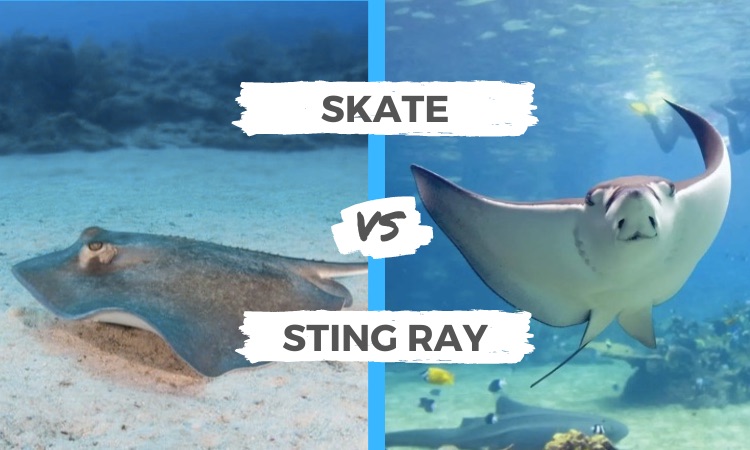It’s easy to mistake skate fish and stingrays for one another due to the fact that both are cartilaginous fishes with flattened, diamond-shaped bodies and an arrangement of gills and mouths on their undersides. These aquatic creatures can be found across the globe in a variety of habitats.
If you look closely, there are indeed some key distinctions between a skate vs stingray. Even though they both like to camouflage themselves by burying in the mud or sand.
So how can anyone identify them from each other? Well, it’s actually quite simple. All you need is an eye for detail! Let us take a closer look at what sets these two bottom dwellers apart.

Stingray vs Skate: Comparisons
Skate fish and stingrays are both cartilaginous species of sea life, sharing the same skeletal structure made from flexible cartilage rather than traditional bone.
All sharks, rays, skates and sawfish belong to the subclass Elasmobranchii and are part of the class Chondrichthyes. Therefore, skate fish and stingrays can be defined as cartilaginous fish.
With more than 400 varieties of rays and skates, the oceans provide us with a plethora of aquatic life. Not only are there differences that remain undetectable to our eyes, but also many distinctions that are visible to us all.
The Main Differences Between Skate and Stingrays
Skate fish and stingrays are both cartilaginous creatures, however they differ in many ways. The most prominent being their level of danger.
Whilst a stingray is considered to be hazardous, skatefish pose little risk. Additionally, the tail on a skatefish tends to be thicker and shorter compared to that of its counterpart.
Not only do sharks and dolphins have distinct sets of teeth, they also reproduce and give birth in strikingly divergent ways!
Exploring into the depths of these captivating creatures reveals even more to be discovered. In order to understand the distinction between a skate vs stingray, let us delve deeper into the comparison.

Skate vs Stingray: Teeth
Skate fish and stingrays differ in more than just appearance. They also have distinct types of teeth. While a traditional tooth structure may not be apparent with the latter, rest assured that stingrays do indeed possess them!
To be specific, their enamel is formed into flattened plates made from modified placoid scales or dermal denticles that are comparable to those seen on sharks’ bodies. Fascinatingly enough, it’s these denticles that give both species an extra layer of armor-like protection against enemies as well as rough surfaces encountered underwater.
Not only that, but stingrays similarly to sharks are always replenishing their teeth. They make new ones at the back and push them forward as soon as they’re required – so there is never a shortage of sharpness! Stingrays primarily feast on crustaceans, shrimp, worms and clams for sustenance.
Skate fish possess an extraordinary attribute that sets them apart from other species; their tiny, pointed teeth. This sharp set of chompers is used to devour crustaceans, clams, shrimp, worms and small-to-medium sized fish. This makes skate a powerful predator in the sea!
Skate vs Stingray: Tail
One immediately discernible distinction between skate fish and stingrays is their tails. Stingrays have an elongated whip-like tail that comes with a lanceolate barb, or stinger, at the end which gives them their moniker of “stingray.”
Stingrays are equipped with a heavily-barbed tail, which is loaded with potent venom and serves as the creature’s defensive tool. Sadly, it can be deadly to humans should they come into contact with this sharp barb – making its sting one of fatal consequences. Skate fish possess thicker tails that tend to measure shorter than those of their stingray counterparts.
Sea skate may not have venomous barbs, but they still boast an effective defense system. Their tails are lined with sharp spikes and thorns that run down the middle of their back to protect them from predators.

Stingray vs Skate Fish: Fins
Skate fish have two lobes to their pelvic fins, in addition to a prominent dorsal fin. Stingrays on the other hand possess only one lobe attached to their pelvic fins; furthermore, its dorsal fin is either absent or minuscule and difficult to spot when it’s visible.
Reproduction
In comparison to other fish, stingrays and skates uniquely reproduce. Stingrays are viviparous, meaning they deliver live offspring (which are called pups) that have already been fully developed within the mother’s body before birth.
Skate fish are oviparous, meaning they lay eggs in a unique way – inside an egg case called a “mermaid’s purse”.
This mysterious-looking black rectangle has arm-like extensions popping out of each corner. Each species of skate fish creates its own distinct type of egg case. After 12 weeks, the cases hatch and these amazing creatures emerge!


